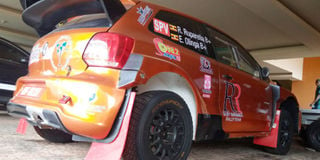Prime
The weight of a rally car determines how fast it goes

Rally enthusiasts are obsessed with race cars because of their extraordinary speeds. Looking at Rajiv Ruparelia’s Polo Proto digital screen that is positioned on the co-driver’s side, one of the fastest speeds it has been driven at is 173km/hour.
Even then, Ruparelia says it has capacity to go faster. It has no maximum speed limit like most, if not all normal cars, but rather a digital speedometer that shows you the highest speed you have driven at.
“My car has a sequential gearbox. When I start the engine, I depress the clutch to engage the first gear. When it starts moving, I don’t need to engage the clutch again. I don’t need to lift the foot off pedal. I can keep it down to change the gears. There are few automatic rally cars but they are not anywhere as good as a manual rally car,” Ruparelia starts.
Service and maintenance
Ruparelia says because it is fragile, sensitive and prone to damage, the care you give a rally car should be supreme. For instance, he says, one wrongly connected rally car cable can pull you out of a race.
“Driving at 170km/hour or 180km/hour and sometimes 200km or 220km/hour subjects the car to heating. To prevent massive damage, the entire car has to be checked and repaired all the time,” Ruparelia says.
“Tyres tend to wear out faster due to sharp turns because they then grip too much. If the car slides a bit, it does not eat up much of the tyre treads. I do not take chances with rally tyres but prefer having them replaced after every rally or two,” Ruparelia adds.
On average, one rally car tyre costs between $300 (about Shs1.1m to Shs1.8m).
Performance
According to Mike Mwangi, a rally car technician, in terms of engine performance, transmission and suspension, rally cars are different from any other car.
“For example a rally car engine is properly tuned despite it being with a handicap of air inlets where a restrictor is put, but still produces a lot more power than normal car engines. The transmission has got dog boxes and Limited Slip Differential (LSD) systems that are not in most normal cars,” Mwangi says.
Safety features
Rally car safety features such as their engine performance are also different. They are stripped off to bare shells and fitted with very strong internal all-round roll cages, inbuilt fire extinguishers, special crisscrossing safety seatbelts and bucket seats.
A rally driver’s suit is also fire resistant to keep both the driver and the co-driver safe. The car also has a seatbelt cutter in case of an emergency and comes with two spare tyres.
The body of the car is reinforced in specific places, especially the suspension points. It has extra air intake ducts, safety guards such as oil sump guards and floor guards, double differential guards and strong mud flaps.
Service
According to Mwangi, service for a rally car is three way; before the rally, during and after the rally. Before the rally, some rally car owners semi-strip their cars while others fully strip them to make sure everything is in order, rebuild it and carry out tests.
During the rally, after about two stages, the driver goes back to the technician who takes approximately 15 to 20 minutes checking the car, either repairing or replacing what needs to be replaced, including the suspension unit. Otherwise, the rally driver may get penalised or even get disqualified.
Special features
Some rally cars have speedometers while others don’t. The ignition switch (start button) of the Polo Proto is located where the hand-pulled handbrake is located, not next to the steering wheel.
“Mine has a rev counter and one screen carrying everything I need to know such as oil pressure and temperature. If there is a problem, the screen flashes and warns the co-driver who alerts me. Once I stop, I can see the top speed I hit. The fuel gauge is positioned in the car trunk next to the spare tyres,” Ruparelia says.
Engine size
Mwangi notes that rally car engine sizes have classes. There is the turbocharged, non-turbo, over and under two litres respectively.
For instance, the Polo Proto has a two-litre turbo engine, the same engine as the Evo 10 (another type of rally car) and this comes with approximately 280 horsepower with a restrictor.
“The weight of the rally car determines how fast it goes. The lighter the car, the faster and the better it drives. This means that most rally cars are lighter than normal cars because they remove a lot of unnecessary components that make it heavy and slower. Much as some rally cars come with, and some do not come with fuel gauges, they are not that useful in rally cars,” Mwangi explains.
“Rally cars are safe and this explains why they are driven the way they are. Chances of getting injured are minimal even at high speeds. However, you cannot drive a normal car such as a Toyota Mark X like you are driving a rally car. This way you risk causing an accident,” Ruparelia concludes.




